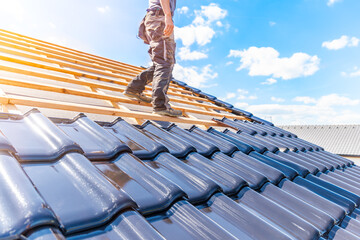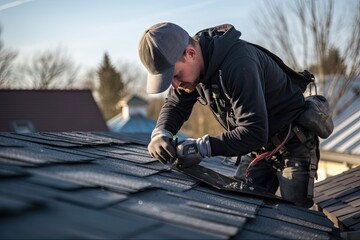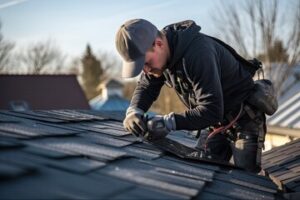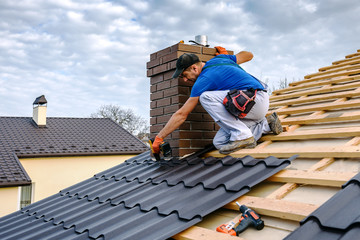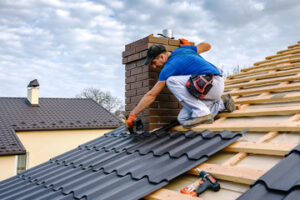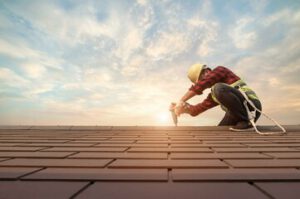Hiring Lakewood Roofing Contractor ensures that your roof remains durable and secure. Roofs protect homes and buildings from weather and external damage. Proper installation and maintenance improve longevity. Skilled contractors provide expert handling for complex roofing needs.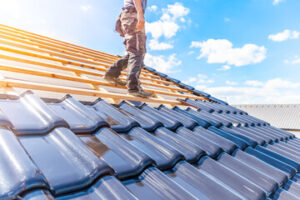
A roofing contractor assesses the condition of the existing roof. They inspect for signs of damage, leaks, and structural issues. Accurate evaluation determines the best repair or replacement approach. Professional assessment prevents further deterioration.
Roof material selection is crucial for long-term performance. Contractors recommend materials based on climate, structure, and budget. Proper material choice improves durability and resistance. Different materials handle weather and wear differently.
Installation requires precision and attention to detail. Contractors measure and cut materials to fit properly. Proper alignment prevents water leaks and wind damage. Secure installation reduces maintenance costs.
Re-roofing involves removing old materials and replacing them with new ones. Contractors handle debris removal and surface preparation. Clean surfaces improve material adhesion. Professional handling ensures smooth and even layering.
Roofing repairs address damaged or worn sections. Contractors fix leaks, cracks, and loose shingles. Timely repairs prevent structural issues. Regular maintenance improves overall roof integrity.
Roof ventilation affects indoor temperature and moisture levels. Contractors install vents and airways for proper airflow. Balanced ventilation reduces humidity and heat buildup. Improved airflow extends roof life.
Roof insulation improves energy efficiency and comfort. Contractors install insulation beneath the roof deck. Proper insulation reduces heating and cooling costs. Consistent indoor temperature improves comfort.
Flashing installation prevents water leaks at roof joints. Contractors use metal or rubber materials for sealing. Proper alignment prevents water infiltration. Flashing protects vulnerable roof areas.
Gutter installation improves water drainage. Contractors install seamless gutters for better flow. Proper slope prevents water pooling and overflow. Clean gutters protect roof edges and siding.
Downspout placement ensures proper water diversion. Contractors position downspouts away from the foundation. Controlled drainage prevents soil erosion and structural damage. Downspouts protect landscaping and pathways.
Chimney and skylight sealing prevents leaks. Contractors apply waterproof seals around openings. Proper flashing and caulking improve water resistance. Professional handling prevents drafts and moisture damage.
Roof coating protects materials from UV damage and weathering. Contractors apply reflective or waterproof coatings. Proper coating improves heat resistance and water runoff. Coated roofs last longer and require less maintenance.
Roof reinforcement improves wind and impact resistance. Contractors install bracing and structural support. Reinforced roofs handle storms and heavy loads better. Proper support prevents sagging and collapse.
Roofing for commercial buildings requires large-scale handling. Contractors handle wide surface areas and complex designs. Proper material and structural support improve longevity. Commercial roofs require specialized maintenance.
Residential roofing involves customized designs and materials. Contractors adjust materials for roof pitch and structure. Proper sealing and reinforcement prevent leaks. Residential roofs require regular inspection.
Flat roofing requires proper drainage and sealing. Contractors install sloped layers and waterproof membranes. Proper drainage prevents water pooling. Reinforced surfaces handle foot traffic and weathering.
Sloped roofing improves water runoff and wind resistance. Contractors install shingles or tiles for secure coverage. Proper overlap prevents water infiltration. Sloped roofs improve structural balance.
Metal roofing requires precision cutting and alignment. Contractors secure panels with hidden fasteners. Proper sealing prevents rust and corrosion. Metal roofs handle heavy weather conditions effectively.
Tile roofing involves delicate handling and alignment. Contractors secure tiles with proper spacing. Reinforced underlayment improves moisture resistance. Tile roofs handle heat and impact well.
Wood roofing requires treated materials for weather resistance. Contractors secure shingles with corrosion-resistant nails. Proper sealing prevents warping and moisture absorption. Treated wood handles weather changes better.
Synthetic roofing materials provide lightweight and durable coverage. Contractors install synthetic shingles or panels. Proper sealing improves water resistance. Synthetic materials handle UV exposure and moisture well.
Emergency roofing repairs address sudden damage. Contractors handle storm damage and fallen debris. Quick response prevents further water infiltration. Temporary seals protect interiors until permanent repairs.
Roofing inspections identify hidden damage and wear. Contractors use thermal imaging and moisture meters. Accurate assessment prevents future problems. Regular inspections improve long-term performance.
Stormproofing improves resistance to high winds and debris. Contractors install reinforced shingles and bracing. Proper sealing prevents uplift and damage. Stormproof roofs handle extreme weather better.
Roof drainage systems improve water flow and prevent pooling. Contractors install internal or external drains. Proper alignment prevents overflow and water damage. Drainage systems protect roof edges and siding.
Roofing for historical buildings requires specialized materials and techniques. Contractors match original designs and materials. Proper handling preserves architectural integrity. Historical roofs require expert restoration.
Roofing for solar panels involves reinforced supports and alignment. Contractors secure panels to prevent uplift. Proper sealing protects against water infiltration. Reinforced structures handle panel weight and wind pressure.
Green roofing requires plant-friendly materials and drainage. Contractors install waterproof membranes and soil layers. Proper slope prevents water buildup. Green roofs improve insulation and air quality.
Cool roofing improves energy efficiency and heat reflection. Contractors install reflective materials and coatings. Proper sealing prevents heat absorption. Cool roofs reduce cooling costs and improve comfort.
Roofing for warehouses requires durable and load-bearing surfaces. Contractors install reinforced materials and bracing. Proper sealing handles moisture and temperature changes. Warehouse roofs handle equipment and storage weight.
Roofing for schools requires noise and impact resistance. Contractors install soundproofing and durable materials. Proper sealing improves insulation and comfort. Reinforced roofs handle student activity and weather exposure.
Roofing for hospitals involves sterile and insulated materials. Contractors install moisture-resistant and fireproof materials. Proper sealing prevents air leaks and contamination. Hospital roofs handle medical equipment weight and ventilation.
Roofing for sports facilities requires lightweight and durable materials. Contractors install weather-resistant panels and bracing. Proper sealing handles moisture and wind pressure. Reinforced structures handle crowd weight and weather impact.
Roofing for military buildings requires impact and fire resistance. Contractors install reinforced and fireproof materials. Proper sealing prevents structural compromise. Military roofs handle pressure and environmental stress.
Roofing for airports involves wide and stable surfaces. Contractors install weather-resistant materials and supports. Proper drainage handles rain and snow accumulation. Airport roofs handle heavy traffic and vibration.
Roofing for factories involves chemical and heat resistance. Contractors install corrosion-resistant materials and insulation. Proper sealing prevents air leaks and heat loss. Factory roofs handle heavy equipment and ventilation.
Roofing for malls requires soundproofing and climate control. Contractors install reinforced materials and insulation. Proper sealing improves comfort and energy efficiency. Mall roofs handle foot traffic and weather exposure.
Roofing for theaters involves acoustic and weather protection. Contractors install soundproof and moisture-resistant materials. Proper sealing improves comfort and performance quality. Theater roofs handle crowd noise and structural pressure.
Roofing for data centers involves heat and moisture control. Contractors install insulated and fireproof materials. Proper sealing prevents air leaks and equipment damage. Data center roofs handle heavy equipment weight and heat output.
Roofing for religious buildings involves architectural preservation and weatherproofing. Contractors match original designs and materials. Proper sealing prevents leaks and structural damage. Reinforced roofs handle weather and environmental exposure.
Roofing for retirement homes involves noise reduction and insulation. Contractors install soundproof and moisture-resistant materials. Proper sealing improves comfort and indoor air quality. Reinforced roofs handle environmental changes and resident activity.
Roofing for entertainment venues requires soundproofing and impact resistance. Contractors install weatherproof and acoustic materials. Proper sealing prevents leaks and noise disruption. Reinforced roofs handle large crowds and weather exposure.
Roofing for museums requires climate control and moisture resistance. Contractors install insulated and fireproof materials. Proper sealing prevents air leaks and damage to exhibits. Museum roofs handle temperature changes and humidity.
Roofing for residential communities involves coordinated design and material selection. Contractors ensure uniform appearance and performance. Proper sealing improves long-term durability. Reinforced roofs handle weather changes and resident activity.
Hiring a skilled roofing contractor ensures secure and long-lasting results. Professional handling improves installation accuracy and durability. Regular maintenance prevents damage and extends roof life. Choosing an experienced contractor ensures reliable protection and performance.
